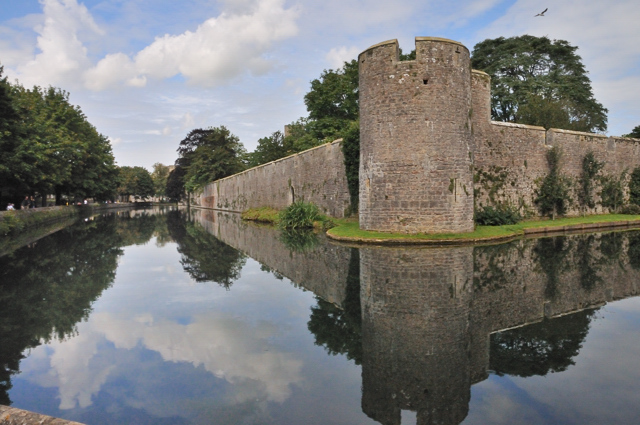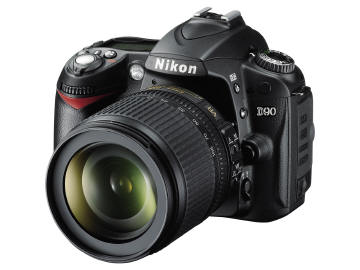Feature Week
Abbeys
Plus NIKON D90 announced
Some will find this one of the most exciting featured items, others perhaps will be less excited, and some may be put off by the religious connection, or the feel that these were part of our history we could have better done without. Many will have misconceptions, and have got questionable historic facts, with history nothing is ever as simple as presented. Yes, you had some Norman bishops brought in, who had castle grade fortified palaces complete with moats, collected taxes and were a part of the ruling class, profiteering at every opportunity, but you also had monasteries that looked after the homeless and poor, that assisted travellers and looked after sailors when on land, that provided medical care, and a lot more besides.
|
|
|
Reflections in the Bishops Palace Moat, Wells |
On this day I was
using just high ISO and no flash to photograph inside Wells cathedral.
Some outside shots were also used with
high ISO for comparisons.
Perhaps you are aware of the diversity of religious buildings and long history represented or perhaps when you have been looking at places to go you have come across leaflets and entries for this abbey or that abbey, and spotted there are rather a lot of them. Prior to the dissolution of the monasteries in the time of Henry VIII, there were many more, and over 800 were taken over by the Crown at that time. Many knocked down or converted, some used in part for parish churches or cathedrals, and some just abandoned.
As a part of the run up to the Crown taking the Abbey properties and assets, representatives were sent out to every church to tell congregations several things, getting them on their side, one of these was that if the King took over these assets, amounting to over 15% of the land in England, and other income streams, then this would give the King and Government sufficient income, that the people of England would never need to pay taxes again. Of course it did not quite work out that way in the longer term. If that promise had been honoured there would be no VAT, fuel tax, income tax, NI, council tax, or any of the thousand stealth taxes, and disposable incomes after necessities would be perhaps over 10 times what they are today. Of course it all went wrong when they wanted money for a war, and as today money for wars is always found while at the same time small amounts for drugs that people need or operations cannot be found, unless it or you are a special case.
Most abbeys are built around a common plan, the abbey church the largest and most superb building in the shape of a cross with its top pointing sort of east'ish, pointing, the west end and entry often being rather grand, with a second elaborately carved entry on the south. To the south you have the cloisters, square covered area, and of this most other parts are accessible. The second grandest room being the chapter house. Many of our cathedrals, like Salisbury, Wells, Gloucester, Westminster Abbey... were abbey churches, and many more have survived as parish churches, so we have the opportunity to explore complete examples as well as ruins, although with the ruins its often easier to understand the parts and how they were put together. Exploring several ruins by the same order, often allows you to get a picture in your mind of what a complete abbey would have looked like.
There are also many stories to unravel, from who set up the original abbeys and what their belief was, pre catholic, the many items that attracted pilgrims, legends of people walled up for falling in love, and why some fell down while others are still standing. If you have driven through Wiltshire, you may have seen Malmesbury Abbey, large and visible for miles around, but what we see toady is only a part of the nave, less than half its length, the transepts also have gone, it had a great west entrance but it fell down, it had a spire taller than Salisbury cathedral, but that fell down as well.
For the photographer, abbey ruins present many opportunities, the ruins themselves both from an artistic and documentary viewpoint, often plants and nature as well as their place within the landscape. Within the last couple of weeks, at abbeys, we have photographed many butterflies, a lot different plants, a heron, as well as many other birds, a re-enactment group, a presentation of a medieval kitchen, a medieval herb garden with herbs for healing as well as cooking, really good reflections in the moat of a bishops palace, in addition we have taken photos of parts of abbeys, of a wide range or remains, restoration work being carried out, stone carvings, shots of landscapes, and of people exploring them. In addition in cathedrals that were at one time abbeys we have also taken other shots of the architecture, fittings, ceilings, tombs and stain glass windows.
Although we have visited more religious houses in the last few weeks, than we normally would as we we were working towards this feature week, looking back through the years, they have featured throughout. In addition to the photography possibilities its the chance to play time detective that attracts me and many others, we can look at abbeys, castles and other heritage remains and add one piece of knowledge to another, spotting the abnormal or unusual, working out how things worked and knowing the 'normal' layouts deduce where other parts would have been, and perhaps at times disagree with the labelling of the site.
This week we are starting this section, but we did not have sufficient time to complete all that we had hoped to. We have been working on a master index of all sites in the country, identifying where churches and other buildings have come from abbeys, a large indexing task organised both nationally and by county, but its not quite complete, and rather than put it up as it is we decided to complete it first. We hope to have this done by next week. We have also decided to expand the section to include a full listing on all cathedrals and other major cathedral scale churches, but due to the larger list taking far longer than expected this one has also been delayed.
What we do have for you this week is the main articles for this new section, looking at the history, the orders involved in building abbeys, the normal layout, what happened in the abbey day, and a range of feature and other locations guides that introduce some of the sites that you might like to visit. We also have an article on how to go about photographing abbey ruins.
Next week we have the month changeover and new photographers diary, and some other items as well as completing this stage of the Abbey section, with an article on photographing in cathedrals and abbeys currently in use, and we hope to have the listings available as well. These parts are in part connected into some of this weeks articles but with there links greyed out this week.
New Section -
Abbeys and
Monasteries
![]()
Introduction to abbeys
section
![]() looks at what you can find, how as a time detective you can deduce far more and
introduces the other information within this section.
looks at what you can find, how as a time detective you can deduce far more and
introduces the other information within this section.
Christianity in Britain,
![]() looks at how Christianity arrived in Britain and the early history, including
the development of Celtic and Roman branches of the Christian faith and their
amalgamation.
looks at how Christianity arrived in Britain and the early history, including
the development of Celtic and Roman branches of the Christian faith and their
amalgamation.
The development of Monasteries and
Abbeys in Britain
![]() looks at how monasteries came about, the development of the brands,
numbers involved and why each developed and eventually fell out of favour.
looks at how monasteries came about, the development of the brands,
numbers involved and why each developed and eventually fell out of favour.
Dissolution of the
Monasteries
![]() looks at the background to, and what was going on in Europe, what led to and the
results of the dissolution of the monasteries, which had little to do with
who Henry VIII wished to marry.
looks at the background to, and what was going on in Europe, what led to and the
results of the dissolution of the monasteries, which had little to do with
who Henry VIII wished to marry.
The
layout of a Monastery or
Abbey,![]() looks
at an early complete design of a Benedictine Monastery, and also looks at
some later differences.
looks
at an early complete design of a Benedictine Monastery, and also looks at
some later differences.
A Day at the Abbey,
![]() looks at the
life of the monks who lived there and how they used much of the space we
discover in buildings now.
looks at the
life of the monks who lived there and how they used much of the space we
discover in buildings now.
Battle Abbey and Battlefield,
Battle, East Sussex
![]()
![]()
![]()
Bishop's Waltham Palace, Bishops Waltham,
Hampshire
![]()
![]()
Dundrennan Abbey, Dundrennan, Dumfriesshire,
Scotland
![]()
![]()
Egglestone Abbey, Barnard Castle, Durham
![]()
![]()
Glastonbury Abbey,
Glastonbury, Somerset
![]()
Hailes Abbey, nr Winchcombe,
Gloucestershire
![]()
![]()
![]()
Holmcultrum Abbey, nr Abbey
Town, Cumbria
![]()
![]()
![]()
Hulne Priory,
Hulne Park, Alnwick,
Northumberland
![]()
![]()
![]()
Lenses Abbey, Abbey Wood,
Belvedere, London
![]()
![]()
![]()
Lilleshall Abbey,
nr Telford, Shropshire
![]()
![]()
![]()
Jervaulx Abbey,
Middleham, Yorkshire
![]()
![]()
Michelham Priory & Gardens,
Upper Dicker, nr Hailsham, East Sussex
![]()
![]()
Muchelney Abbey,
nr Ilchester, Somerset
![]()
![]()
Netley Abbey
nr Fareham, Hampshire
![]()
![]()
![]()
Newark Priory, Pyrford, Surrey
![]()
![]()
![]()
Roche Abbey, Maltby, Rotherham,
Yorkshire
![]()
![]()
![]()
Southwick Priory,
Nr Porchester, Hampshire
![]()
![]()
![]()
Whitby Abbey,
Whitby, Yorkshire
![]()
![]()

